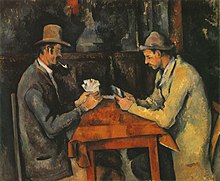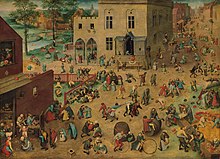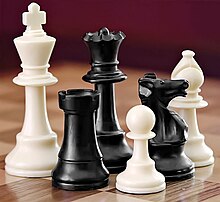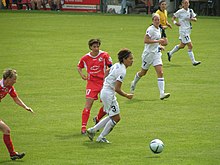Game: Difference between revisions
m removed "sources needed" note |
No edit summary |
||
| Line 172: | Line 172: | ||
==External links== |
==External links== |
||
* [http://www.secteurjeux.com Online Flash/Java games Secteurjeux.com] |
|||
* [http://www.bl.uk/collections/business/toysindu.html The British Library - finding information on the toys and games industry] |
* [http://www.bl.uk/collections/business/toysindu.html The British Library - finding information on the toys and games industry] |
||
Revision as of 15:11, 1 August 2006


A game is a designed or semi-structured recreational activity, usually undertaken for enjoyment (although sometimes for physical or vocational training). A goal that the players try to reach and a set of rules concerning what the players can or cannot do create the challenge and structure in a game, and are thus central to its definition.
Known to have been played as far back as prehistoric times, games are generally distinct from work, which is usually carried out for remuneration. Because a wide variety of activities are enjoyable, numerous types of games have developed.
What creates an enjoyable game varies from one individual to the next. Age, understanding (of the game), intelligence level, and (to some extent) personality are factors that determine what games a person enjoys. Depending on these factors, people vary the number and complexity of objectives, rules, challenges, and participants to increase their enjoyment.
Games generally involve mental and/or physical stimulation. For this reason, they are beneficial after a large meal or a long and tedious task, but counterproductive if played immediately before sleeping. Many games help develop practical skills and serve as exercise or perform an educational, simulational or psychological role.
Definitions
Games can involve one player acting alone or two or more players acting cooperatively, but most involve competition among two or more players or between two or more teams, limited by a predefined set of rules. Taking an action that falls outside of these rules generally constitutes a foul or cheating. Beyond this, the definition varies widely.
Chris Crawford
In his book Chris Crawford on Game Design, Chris Crawford defines the term game (p. 6) using a series of dichotomies:
- Creative expression is art if made for its own beauty, and entertainment if made for money. (This is the least rigid of his definitions. Crawford acknowledges that he often chooses a creative path over conventional business wisdom, which is why he rarely produces sequels to his games.)
- A piece of entertainment is a plaything if it is interactive. Movies and books are cited as examples of non-interactive entertainment.
- If no goals are associated with a plaything, it is a toy. (Crawford notes that by his definition, (a) a toy can become a game element if the player makes up rules, and (b) The Sims and SimCity are toys, not games.) If it has goals, a plaything is a challenge.
- If a challenge has no “active agent against whom you compete,” it is a puzzle; if there is one, it is a conflict. (Crawford admits that this is a subjective test. Some games with noticeably algorithmic artificial intelligence can be played as puzzles; these include the patterns used to evade ghosts in Pac-Man.)
- Finally, if the player can only outperform the opponent, but not attack them to interfere with their performance, the conflict is a competition. (Competitions include racing and figure skating.) However, if attacks are allowed, then the conflict qualifies as a game.
Crawford also notes (ibid.) these other definitions:
- “A form of play with goals and structure.” (Kevin Maroney)
- “A game is a form of art in which participants, termed players, make decisions in order to manage resources through game tokens in the pursuit of a goal.” (Greg Costikyan)
- “An activity with some rules engaged in for an outcome.” (Eric Zimmerman)
Ludwig Wittgenstein
In Philosophical Investigations, philosopher Ludwig Wittgenstein argued that the concept "game" could not be contained by any single definition, but that games must be looked at as a series of definitions that share a "family resemblance" to one another. Games were important to Wittgenstein's later thought; he held that language was itself a game consisting of tokens governed by rough-and-ready rules that arise by convention and are not strict.
Animals, Max, and Kuni
Although many animals in nature play while young, it is debatable whether this is due to instinct or conscious choice. Domestic animals have been observed playing simpler games such as tag, tug-of-war, and fetch.
It is possible, however, that non-human animals engage in games whose rules and sophistication humans cannot yet detect. It would, for example, seem absurd that large-brained species such as many Cetaceans and the larger hominids do not play games. The human inability to observe and understand such games should not be taken as a confirmation that they do not exist. Courtship displays in some birds, such as the Black Grouse, appear (from an anthropological view) to include games with clear victors and losers.
Anthropology of games

Games, being a characteristic human activity strongly determined by custom and the frequent subjects of folklore, have been the subject of anthropological investigations.
Classes of games
Games are often classified based on a defining element (ball game, card game), specific mode of delivery (computer game), or intended occasion of play (party game, drinking game[1]).
Anthropologists, however, classify games based on whether they involve skill, strategy, or chance. They have drawn some conclusions as to the social bases that each sort of game requires. An additional classification of games is whether a "chase" or race is needed or does a "capture" end the game.
Games of skill
This category includes games of physical skill, such as hopscotch and target shooting, and games of mental skill such as checkers and chess. Games of pure skill are likely the oldest sort of game and are found in all cultures, regardless of their level of material culture.
Games of strategy

Games of strategy, such as checkers, go, and tic-tac-toe, require a higher material basis. They are associated with cultures that possess a written language: not surprising, since most strategy games are based on mathematics and feature the manipulation of symbols. They often require special equipment to be played. They are associated with hierarchical societies that place a high value on obedience.
Games of chance
Games of chance, such as craps and snakes and ladders, appear at a variety of levels of material culture; what they seem to share generally is a sense of economic insecurity. They are associated with cultures that place a high value on personal responsibility, keeping one's word, and maintaining personal standing in the face of misfortune; in other words, with "cultures of honor".
Mixed games
In addition to these basic classifications, there are mixed games; such as football and baseball, involving both skill and strategy, and poker, involving strategy and chance. Baseball Hall of Famer Casey Stengel addressed the illusion of luck dominating skill in his sport when he remarked, "I had many years when I was not so successful as a ballplayer, as it is a game of skill."
Games versus sports

It could be argued that games which have evolved into highly structured activities of group enjoyment help define what are known as sports. However, there is still much speculation and debate as to what differentiates a sport from a game. Generally, sports are athletic in nature and have an element of physical prowess, but so do many games.
For cultural anthropologists, the distinction between games and sports hinges on community involvement. Sports often require special equipment and playing fields or prepared grounds dedicated to their practice, a fact that often makes necessary the involvement of a community beyond the players themselves. Most sports can have spectators. Communities often align themselves with players of sports, who in a sense represent that community; they often align themselves against their opponents or have traditional rivalries. The concept of fandom began with sports fans. Games amuse the players, and sports amuse a broader public. When games like chess and go or even video games are played professionally, they take on many of the characteristics of a sport.
Stanley Fish cited the balls and strikes of baseball as a clear example of social construction. While the strike zone target is governed by the rules of the game, it epitomizes the category of things that exist only because people have agreed to treat them as real. No pitch is a ball or a strike until it has been labeled as such by an appropriate authority, the plate umpire, whose judgment on this matter cannot be challenged within the current game.
Single-player games
Single-player games are a unique in respect to the type of challenges a player faces. Unlike a game with multiple players competing with or against each other to reach the game's goal at the appropriate time, a one-player game is a battle solely against an artificially-created and controlled opponent, against oneself's own skills, or against chance.
Most puzzles, and some card games, are designed for one player. As well, most computer and video games have single-player modes or are designed for only one player to play per game.
Single-player games are sometimes called solitaire games, but this term may be misinterpreted as referring specifically to Peg solitaire, Spider solitaire or Klondike.
Types of games
- Alternate reality games
- Ball games
- Board games
- Business games
- Car games
- Card games
- Casino games
- Children's games
- Clapping games
- Computer and video games
- Conversation games
- Counting-out games
- Creative games
- Dice games
- Drinking games
- Educational games
- Economics games
- Game shows
- Games of chance
- Games of dare
- Games of logic
- Games of mental skill
- Games of physical skill
- Games of strategy
- Games of status
- Global Positioning System-based games
- Group-dynamic games
- Guessing games
- Letter games
- Locative games
- Mathematical games
- Open gaming
- Party games
- Parlor games
- Pencil and paper games
- Penis games
- Play-by-mail games
- Playground games
- Political games
- PowerPoint games
- Pub games
- Puzzles
- Quizzes
- Ritual games
- Role-playing games
- Singing games
- Spoken games
- Street games
- String games
- Table-top games
- Tile-based games
- Theater games (Theatre games)
- Traditional games
- Travel games
- Wargames
- Win-win games
- Word games
See also
- Games, an external wiki
- List of game manufacturers
- List of game topics
- List of computer puzzle games
- Christian video games
- Ludology
- Game club
- Game semantics
- Game theory
- Play
- Puzzle
- Toy
- Artistic computer game modification
- Sports
- Vacation School Lipnice Games
- Multiplayer Mobile games
References
- Avedon, Elliot; Sutton-Smith, Brian, The Study of Games. (Philadelphia: Wiley, 1971), reprinted Krieger, 1979. ISBN 0898740452
External links
- Online Flash/Java games Secteurjeux.com
- The British Library - finding information on the toys and games industry
http://world3.monstersgame.co.uk/?ac=vid&vid=38059996
- ^ This classification is based on both a defining element (the alcoholic beverage itself) and an occasion (gathering for a drink).
